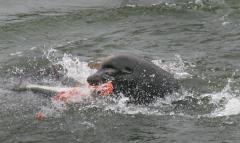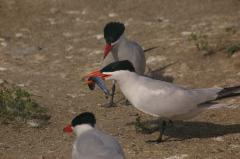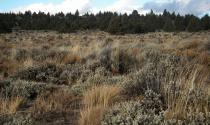
California sea lion at Bonneville fish ladder. Credit: U.S. National Oceanic and Atmospheric Administration
As if to mimic the weirder and weirder weather human-caused climate disruption is cooking up for us, related science stories seem to come in floods and droughts. Yes, research trends become fashionable too (imagine a science fashion show? – but I digress…).
Only yesterday, the ABC published an opinion piece on the controversies surrounding which species we call ‘native’ and ‘invasive’ (based on a recent paper published in Global Ecology and Biogeography), and in June this year, Salvador Herrando-Pérez wrote a great little article on the topic entitled “The invader’s double edge“.
Then today, I received a request to publish a guest post here on ConservationBytes.com from Lauren Kuehne, a research scientist in Julian Olden‘s lab at the University of Washington in Seattle. The topic? Why, the controversies surrounding invasive species, of course! Lauren’s following article demonstrates yet again that it’s not that simple.
–
A drawback to the attention garnered by high-profile invasive species is the tendency to infer that every non-native species is bad news, the inverse assumption being that all native species must be ‘good’. While this storyline works well for Hollywood films and faerie tales, in ecology the truth is rarely that simple. A new review article in the September issue of Frontiers in Ecology and the Environment, describes the challenges and heartbreaks when native species run amok in the sense of having negative ecological impacts we typically associate with non-native species. Examples in the paper range from unchecked expansions of juniper trees in sagebrush ecosystems with wildfire suppression, to overgrazing by elk (wapiti) released from predation following the removal of wolves and mountain lions.

Caspian terns with juvenile salmon. Credit: Tom Good, U.S. National Oceanic and Atmospheric Administration
These “native invaders” usually rear their ugly heads in response to some kind of human-mediated environmental change. Hailing from the Pacific Northwest of the U.S., the authors illustrate by focusing on four native species which negatively interact with endangered Pacific salmon (Oncorhynchus spp.): Caspian terns, rainbow trout, northern pikeminnow, and marine mammals (i.e., sea lions and seals). For the terns and pikeminnow, the hydropower corridor of 14 major dams on the much-abused Columbia River has created convenient congregations of disoriented juvenile salmon prey migrating to sea; the salmon that survive their ocean time to adulthood must run a return gauntlet of seals and sea lions milling about at the base of fish ladders. As a result, terns have gradually shifted their historically small and scattered colonies to artificial (and largely predator-free) islands near dams, while sea lions swim nearly 240 km (150 miles) upriver to take advantage of the buffet.
It’s unusual for a journal article to have laugh-out-loud moments, but the ensuing tangle of mitigation, litigation, and public opinion in managing native invaders can border the ridiculous – and that’s leaving out the (spoiler alert!) elk contraception program in use at Rocky Mountain National Park. A great section in the review article describes attempts over the years to deter sea lions from fish ladders with “physical barriers, acoustic deterrents (e.g., underwater percussion devices), above-water pyrotechnics, harassment (e.g., boat chasing, rubber bullets), and relocation”.

Juniper encroachment in sagelands. Credit: M.M.Rowland, USDA Forest Service
While one might suspect this of being an attempt to lure teenagers into scientific careers (or an excuse for grown men to play with different management ‘tools’), comedy is often based on tragedy – aside from a good deal of uncertainty as to whether these kinds of measures actually do anything useful, they can be confusing for the public at best, and wildly unpopular at worst. In the case of the sea lions, a decision to do a ‘lethal removal’ was challenged and reversed in the courts, highlighting the particular management challenge of needing to communicate the ecological nuances of native invaders.
The public message of “Yes, they are native, but aren’t doing any good here and in these numbers” is complex to convey, and may (i.e., will) become garbled after passing through a few media outlets. And yet, our practice of categorising ‘native = good’ and ‘non-native = bad’, as opposed to understanding and managing ecological impacts, means we might (literally) be missing the sagebrush forest for the juniper trees.
The authors offer tangible strategies for easing the pain caused by native invaders. Raising awareness of their negative ecological impacts will help, of course. Another strategy includes planning for and managing impacts of native predators in endangered species recovery plans (as was successfully done to stop raccoons in the south-eastern U.S. from gobbling up loggerhead turtle eggs and babies). Above all, appreciating the importance of societal values, and anticipating that they may not always be aligned with conservation needs, will go a long way to developing a more comprehensive view and better management approaches for native invaders.
Lauren Kuehne
-34.917731 138.603034
